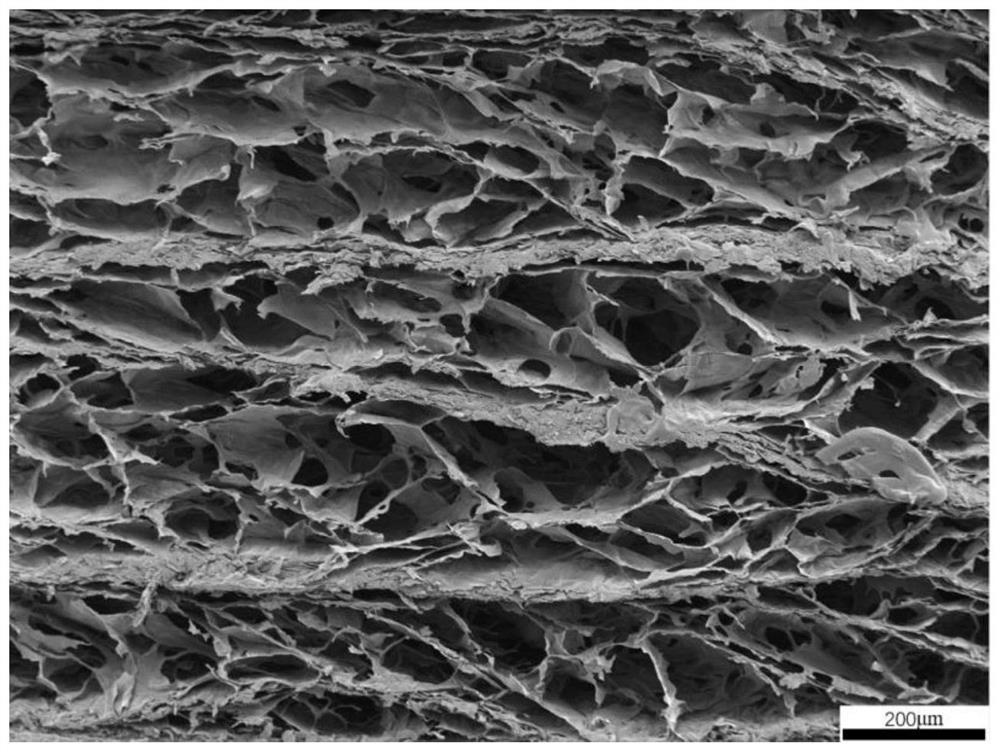Preparation method and application of porous material assembled by graphene oxide and chitosan molecules
A porous material, chitosan technology, used in applications, bandages, surgery, etc., can solve the problems of poor mechanical strength, poor mechanical strength of sponges, inability to exert coagulation effect, etc., and achieve excellent antibacterial properties and improve the effect of coagulation performance.
- Summary
- Abstract
- Description
- Claims
- Application Information
AI Technical Summary
Problems solved by technology
Method used
Image
Examples
Embodiment 1
[0028] A preparation method of a porous material based on graphene oxide and chitosan molecular assembly, specifically comprising the following steps:
[0029] Step 1, taking 2g of chitosan with a degree of deacetylation of 96.2% is dispersed in 80mL of deionized water at a stirring speed of 200rppm, and stirred for 8min to obtain an aqueous dispersion of chitosan;
[0030] Step 2: Take 20 mL of graphene oxide aqueous solution with a concentration of 10 mg / mL, and add it to the chitosan aqueous dispersion under continuous stirring. After 10 minutes, add 10 μL of glutaraldehyde as a cross-linking agent, and continue to heat at 15 ° C, 300 rpm Under the condition of stirring 50min, obtain cross-linked graphene oxide-chitosan aqueous dispersion;
[0031] Step 3: Add 1 mL of glacial acetic acid into the cross-linked graphene oxide-chitosan aqueous dispersion, and continue stirring for 10 h at 25° C. and 1000 rpm to obtain a uniform cross-linked graphene oxide-chitosan solution, fr...
Embodiment 2
[0033] A preparation method of a porous material based on graphene oxide and chitosan molecular assembly, specifically comprising the following steps:
[0034]Step 1, taking 3g of chitosan with a degree of deacetylation of 96.5% is dispersed in 80mL of deionized water at a stirring speed of 300rppm, and stirred for 8min to obtain an aqueous dispersion of chitosan;
[0035] Step 2: Take 20 mL of graphene oxide aqueous solution with a concentration of 5 mg / mL, and add it to the chitosan water dispersion under continuous stirring. After 10 minutes, add 100 μL of glyoxal as a cross-linking agent, and continue at 35 ° C, 100 rpm Under the condition of stirring 40min, obtain cross-linked graphene oxide-chitosan aqueous dispersion;
[0036] Step 3: Add 2 mL of oxalic acid into the cross-linked graphene oxide-chitosan aqueous dispersion, and continue stirring for 5 hours at 45° C. and 1200 rpm to obtain a uniform cross-linked graphene oxide-chitosan solution, freeze-dry, and obtain S...
Embodiment 3
[0038] A preparation method of a porous material based on graphene oxide and chitosan molecular assembly, specifically comprising the following steps:
[0039] Step 1, taking 2g of chitosan with a degree of deacetylation of 86.5% is dispersed in 80mL of deionized water at a stirring speed of 200rppm, and stirred for 8min to obtain an aqueous dispersion of chitosan;
[0040] Step 2: Take 20 mL of graphene oxide aqueous solution with a concentration of 5 mg / mL, and add it to the chitosan water dispersion under continuous stirring. After 10 minutes, add 50 μL of formaldehyde as a cross-linking agent, and continue at 25 ° C and 200 rpm. Down stirring 30min, obtains cross-linked graphene oxide-chitosan aqueous dispersion;
[0041] Step 3: Add 2 mL of concentrated hydrochloric acid into the cross-linked graphene oxide-chitosan aqueous dispersion, and continue stirring for 24 hours at 35° C. and 500 rpm to obtain a uniform cross-linked graphene oxide-chitosan solution, freeze-dry, A...
PUM
 Login to View More
Login to View More Abstract
Description
Claims
Application Information
 Login to View More
Login to View More - R&D
- Intellectual Property
- Life Sciences
- Materials
- Tech Scout
- Unparalleled Data Quality
- Higher Quality Content
- 60% Fewer Hallucinations
Browse by: Latest US Patents, China's latest patents, Technical Efficacy Thesaurus, Application Domain, Technology Topic, Popular Technical Reports.
© 2025 PatSnap. All rights reserved.Legal|Privacy policy|Modern Slavery Act Transparency Statement|Sitemap|About US| Contact US: help@patsnap.com

